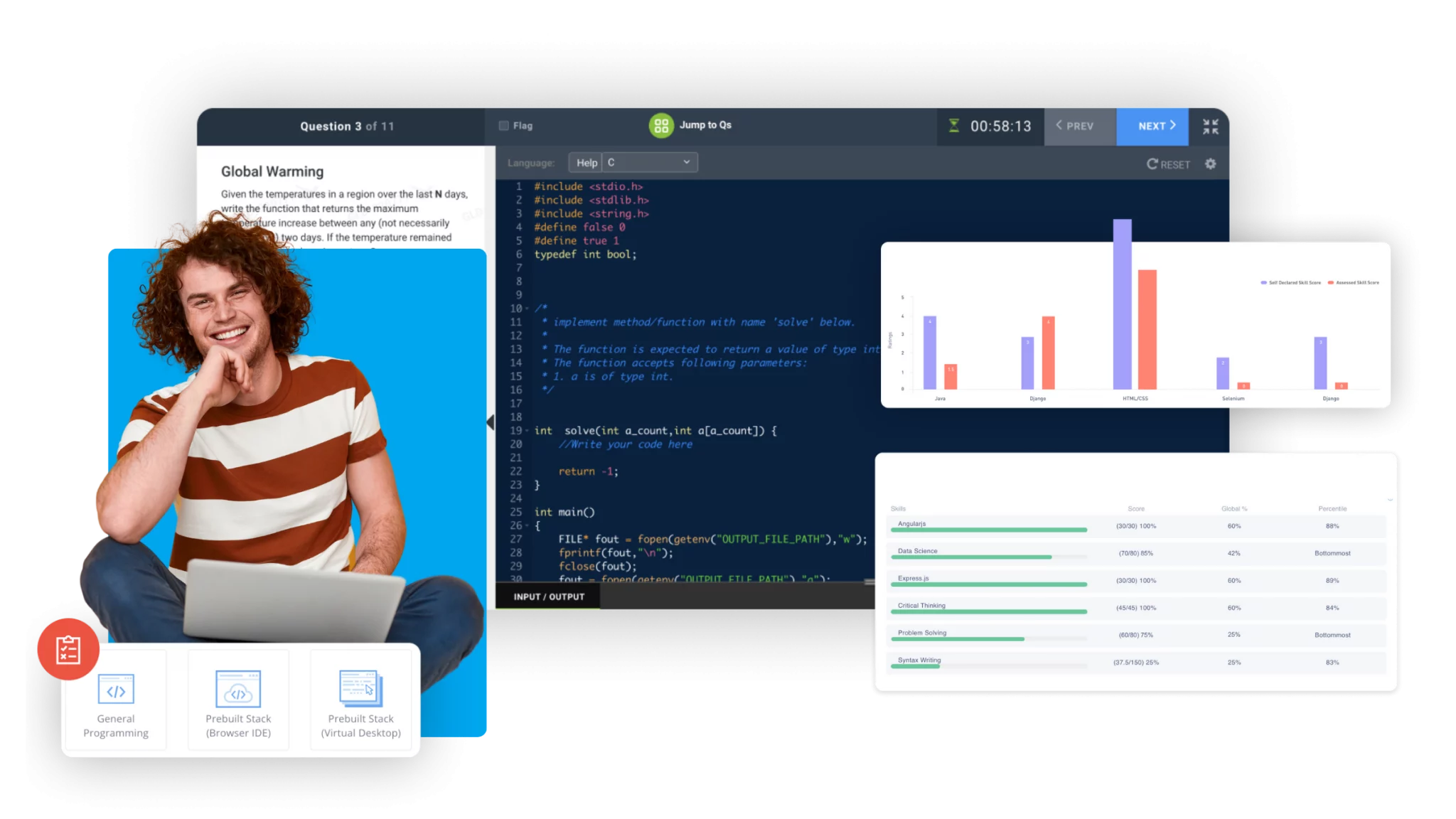Introduction
Conducting a thorough technical evaluation is crucial for hiring the best talent in the technology sector. Technical evaluations help to ensure that candidates possess the necessary skills and expertise to excel in their roles. With the rapid advancement of technology, traditional interview methods are no longer sufficient. Utilizing AI and automated tools can significantly enhance the accuracy and efficiency of technical assessments, ensuring that you hire the most qualified candidates. This guide provides a comprehensive approach to conducting technical evaluations, emphasizing the role of AI in the process.
What is a Technical Evaluation?

A technical evaluation is a detailed assessment of a candidate’s technical skills and abilities. It typically includes coding tests, technical interviews, and practical tasks that simulate real-world job scenarios. The primary objective is to verify the candidate’s proficiency in specific programming languages, tools, and technologies relevant to the job.
Importance of Technical Evaluations
Skills Verification:
- Technical evaluations verify that candidates have the skills they claim on their resumes.
Real-World Readiness:
- By simulating job-related tasks, these evaluations assess a candidate’s ability to handle actual work scenarios.
Objective Assessment:
- Standardized tests provide an objective measure of a candidate’s abilities, reducing biases in the hiring process.
Efficient Screening:
- Technical evaluations help in quickly identifying the most qualified candidates from a large applicant pool.
Step-by-Step Guide to Conducting a Technical Evaluation
Step 1: Define the Requirements
Before you begin the evaluation process, clearly define the technical requirements of the job. Identify the key skills, programming languages, and technologies that are essential for the role. This will help in creating or selecting appropriate assessment tools and tasks.
Step 2: Choose the Right Tools
Selecting the right tools and platforms is critical for an effective technical evaluation. Look for solutions that offer:
Assessments Library:
- Access to a comprehensive library of assessments covering hundreds of programming languages and both technical and non-technical tasks.
Customization:
- The ability to customize the coding environment and assessments to reflect your company’s brand and specific job requirements.
Automation:
- Automated scoring, feedback collection, and progression to the next steps in the hiring process to save time and reduce manual effort.
Standardization:
- Standardized assessment formats that ensure fairness and scalability in the evaluation process.
Diversity and Inclusion:
- Features that remove personally identifiable information (PII) and mask candidate identities to eliminate potential biases and promote diversity and inclusion.
Step 3: Develop the Evaluation Criteria
Develop clear criteria for evaluating candidates’ performance. This should include:
Skill Proficiency:
- Ability to write clean, efficient, and error-free code.
Problem-Solving:
- Capability to solve complex problems and think critically.
Coding Best Practices:
- Adherence to coding standards and best practices.
Real-World Application:
- Ability to apply skills in practical, job-related scenarios.
Step 4: Create or Select Assessments
Based on the job requirements and evaluation criteria, create or select assessments that accurately measure the required skills. Ensure that the assessments are challenging yet relevant to the role. Types of assessments can include:
Coding Tests:
- Evaluate a candidate’s coding skills in specific programming languages.
Technical Interviews:
- Conduct live coding sessions and technical problem-solving interviews.
Practical Tasks:
- Simulate real-world job tasks to assess practical application of skills.
Step 5: Administer the Assessments
Administer the assessments using your chosen platform. Ensure a seamless and user-friendly experience for candidates by providing clear instructions and support. Key features to leverage include:
AI Proctoring:
- Use AI to monitor assessment sessions for any suspicious behavior, ensuring the integrity of the evaluation.
Real-Time Feedback:
- Provide candidates with immediate feedback on their performance, helping them understand their strengths and areas for improvement.
Step 6: Evaluate the Results
Once the assessments are completed, evaluate the results using a combination of automated scoring and review. AI can play a significant role here by:
Automated Scoring:
- Quickly and accurately score assessments based on predefined criteria.
Intelligence:
- Enrich your talent pool with insights on candidates’ skill levels and fit for the role.
Verification:
- Track candidates throughout the screening process to eliminate fake candidates and ensure authenticity.
Step 7: Share and Discuss Results
Share the results with relevant stakeholders using detailed reports and recordings of assessment sessions. This facilitates collaboration and informed decision-making. Key reporting features include:
Interview Summaries:
- Summarize each candidate’s performance, including transcripts and highlights.
Performance Reports:
- Provide insights into candidate performance, assessment usage, DE&I metrics, and potential friction points in the process.
Candidate Reports:
- Generate client-ready reports to expedite candidate submissions and provide comprehensive feedback.
Step 8: Provide Feedback to Candidates
Offer constructive feedback to all candidates, regardless of the outcome. This not only helps candidates improve for future opportunities but also leaves a positive impression of your company.
Leveraging AI in Technical Evaluations
AI-powered tools can significantly enhance the technical evaluation process by providing several key benefits:
AI-Generated Questions:
- Automatically generate relevant and vetted questions based on the job description.
AI Evaluation:
- Evaluate and score candidate responses considering factors from skills to cultural fit.
AI Guidance:
- Guide recruiters during interviews, prompting questions, and providing real-time feedback.
Skill Matching:
- Automatically match candidate skills to the job requirements based on the job description.
Recordings:
- Record assessment sessions for review and sharing with stakeholders.
ATS Integrations:
- Integrate with your Applicant Tracking System (ATS) to streamline the hiring process and update interview data seamlessly.
Common Technical Evaluation Tasks
Here are some common tasks and tests that can be included in a technical evaluation:
Coding Challenges:
- Tasks that require candidates to write code to solve specific problems.
Algorithmic Problems:
- Problems that test candidates’ understanding of algorithms and data structures.
System Design:
- Tasks that require candidates to design scalable and efficient systems.
Debugging Exercises:
- Tasks that require candidates to identify and fix bugs in a piece of code.
Code Review:
- Exercises that assess candidates’ ability to review and provide feedback on existing code.
Best Practices for Technical Evaluations
To ensure a fair and effective technical evaluation process, follow these best practices:
Maintain Consistency:
- Use standardized assessments for all candidates applying for the same role.
Ensure Fairness:
- Use DE&I filters to remove biases and promote a diverse candidate pool.
Take Detailed Notes:
- Document candidates’ performance and feedback during the evaluation.
Communicate Clearly:
- Provide clear instructions and support throughout the assessment process.
Provide Constructive Feedback:
- Offer valuable feedback to candidates to help them improve and feel respected.
A technical evaluation is essential for hiring the best technical talent. With a structured approach and making use of AI-powered tools, organizations can streamline the process, reduce biases, and ensure that they hire candidates who are not only technically proficient but also a great fit for your organization. The right combination of technology and best practices will help companies build a strong and capable technical team ready to tackle the challenges of today’s dynamic tech landscape.



